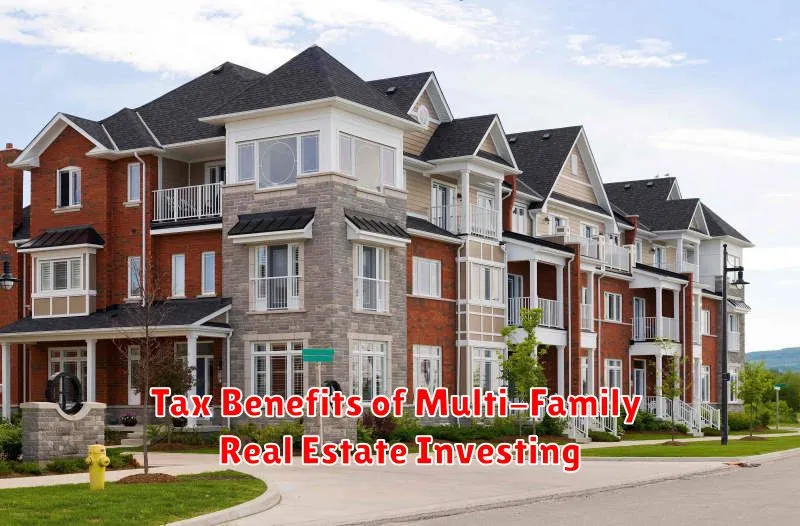Ready to diversify your investment portfolio and build passive income? Look no further than multi-family homes. These properties offer a unique opportunity to own multiple units and generate rental income, providing a steady stream of cash flow and potential for long-term growth. Whether you’re a seasoned investor or just starting your journey, multi-family investing can be a smart strategy to achieve your financial goals.
This comprehensive guide is your one-stop shop for everything you need to know about investing in multi-family properties. We’ll walk you through the basics, from understanding the different types of multi-family homes to finding the right property, financing your investment, and managing your tenants. Get ready to unlock the potential of multi-family investing and discover why it’s a popular choice for both beginners and experienced investors alike.
Understanding the Benefits of Multi-Family Investments
Investing in multi-family properties offers several compelling benefits that make it an attractive option for both seasoned and novice investors. Here’s a breakdown of the key advantages:
Higher Returns: Multi-family properties typically generate higher rental income compared to single-family homes, due to the presence of multiple units. This translates into potentially greater cash flow and overall returns on your investment.
Diversification: Spreading your investments across multiple units within a single property provides diversification, reducing risk compared to owning a single-family home. If one tenant vacates, you have other units to generate income, ensuring a more stable financial stream.
Tax Advantages: Multi-family properties qualify for various tax benefits, including deductions for depreciation, mortgage interest, property taxes, and operating expenses. These advantages can significantly reduce your overall tax liability and enhance your investment returns.
Potential for Appreciation: Like other real estate investments, multi-family properties can appreciate in value over time. Market growth, improvements to the property, and strong local demand all contribute to potential appreciation, increasing your investment’s worth.
Long-Term Stability: Multi-family investments offer the potential for long-term stability and passive income. The rental income generated can provide a consistent cash flow, even as you manage other aspects of your life.
Management Opportunities: With multiple units, you have the opportunity to employ professional property management services, freeing up your time and allowing you to focus on other aspects of your investment portfolio.
Community Building: Owning a multi-family property can provide the opportunity to build a community within your building. Fostering a positive living environment for your tenants can contribute to their satisfaction and long-term residency.
Analyzing Your Investment Goals and Risk Tolerance
Before diving into the world of multi-family home investing, it’s crucial to understand your investment goals and risk tolerance. This foundation will guide your decision-making process and ensure you choose investments that align with your aspirations and comfort level.
Investment Goals: Define what you hope to achieve through multi-family investing. Are you seeking passive income, capital appreciation, or both? Do you have a specific timeframe in mind? Understanding your goals will help you determine the type of property, location, and financing strategies that best suit your needs.
Risk Tolerance: Assess how comfortable you are with potential losses. Multi-family investing involves risks, such as fluctuating rental income, unexpected repairs, and market volatility. Determine your tolerance for these risks and choose investment strategies accordingly. If you’re risk-averse, consider starting with a smaller property or partnering with experienced investors.
Financial Situation: Evaluate your current financial standing. Consider your income, savings, debt levels, and credit score. This assessment will help you determine your investment capacity and the level of financial risk you can afford. It’s essential to have a solid financial foundation before taking on significant investment commitments.
By thoroughly analyzing your investment goals, risk tolerance, and financial situation, you can make informed decisions that align with your overall investment strategy and minimize potential risks. This comprehensive approach will set the stage for successful multi-family investing.
Finding the Right Multi-Family Property for You
Finding the right multi-family property is crucial for successful investment. It involves careful consideration of various factors to ensure a profitable and sustainable venture. Here’s a breakdown of what to look for:
Location, Location, Location: Choose a desirable neighborhood with good schools, amenities, and access to transportation. Research local demographics, rental demand, and potential appreciation.
Property Condition and Potential: Evaluate the property’s condition, including the building structure, plumbing, electrical systems, and landscaping. Consider the potential for upgrades and renovations to enhance the property’s value and desirability.
Unit Mix and Size: Determine the optimal unit mix for your target market. Consider the number of bedrooms and bathrooms, as well as the size and layout of the units.
Rental Income and Expenses: Research the average rental rates in the area and calculate potential rental income. Consider operating expenses like property taxes, insurance, maintenance, and utilities.
Financial Analysis: Evaluate the property’s financial viability by calculating the return on investment (ROI), cash flow, and cap rate. Look for properties with a strong track record of rental income and positive cash flow.
Conducting Thorough Due Diligence Before Buying
Due diligence is the process of investigating a potential investment to determine its suitability. In the context of multi-family homes, due diligence is crucial to ensure that you’re making a sound investment. It involves a thorough examination of various aspects of the property, including its physical condition, financials, and legal status. This process helps you identify potential risks and opportunities, enabling you to make informed decisions.
Financial Analysis
Start by evaluating the property’s financial performance. Review the income and expense statements for the past few years. This will give you an idea of the property’s profitability and the potential for future growth. Also, consider the current market conditions and assess the rental rates. Determine if the property is adequately priced and if it has the potential to generate a positive cash flow. This is crucial for multi-family homes as rental income is essential for making a profit.
Physical Condition
Conduct a comprehensive inspection of the property’s physical condition. This includes checking the roofs, foundations, plumbing, electrical systems, heating and cooling systems, and appliances. You should also consider the property’s exterior, landscaping, and any potential safety hazards. Look for signs of wear and tear, and assess the overall condition of the property to determine the cost of repairs and maintenance.
Legal and Regulatory Issues
It’s important to understand the legal and regulatory environment surrounding the property. Check for zoning compliance, building codes, and any environmental concerns. Review the property’s title and deed, ensuring there are no encumbrances or liens. Investigate any potential lawsuits or legal issues that could affect the property’s value or your investment.
Market Analysis
Research the local market for multi-family homes. Analyze the rental market trends, vacancy rates, and competition. Understand the demographics of the neighborhood and the potential for future growth. This analysis will help you assess the long-term potential of the property and its ability to generate consistent returns.
Professional Assistance
You should consider seeking professional advice during your due diligence process. Engage a qualified real estate agent, property inspector, and an attorney to guide you through the complex aspects of buying multi-family homes. Their expertise will ensure you are making informed decisions and minimizing potential risks.
Financing Your Multi-Family Property Purchase
Securing financing for a multi-family property is crucial for your investment journey. Lenders assess your financial profile and the property’s potential to determine the loan terms. Here’s a breakdown of the key aspects to consider:
Loan Types:
- Conventional Loans: Offered by banks and credit unions, they typically require a down payment of 20% or more. These loans are often the most accessible for experienced investors.
- FHA Loans: Backed by the Federal Housing Administration, these loans offer lower down payment requirements (as low as 3.5%) and flexible credit score standards, making them suitable for first-time investors.
- Commercial Loans: Designed for larger multi-family properties, these loans offer higher loan amounts and potentially lower interest rates compared to residential loans.
Down Payment: The required down payment can range from 15% to 30% depending on the loan type and lender’s policies. Having a substantial down payment can enhance your loan approval chances and secure more favorable terms.
Credit Score: A strong credit score is essential for securing financing. Higher scores indicate financial responsibility and increase your eligibility for lower interest rates.
Debt-to-Income Ratio (DTI): Lenders assess your DTI, which compares your monthly debt payments to your gross monthly income. A lower DTI increases your chances of loan approval and better interest rates.
Property Appraisal: An appraisal is crucial to determine the property’s fair market value. Lenders use the appraisal to assess the property’s worth and determine the loan amount.
Rental Income: Lenders analyze the rental income generated by the property to assess its profitability and ensure you can cover loan payments.
Due Diligence: Conduct thorough research on various lenders, compare loan terms, and select the option that best suits your investment goals and financial situation.
Expert Guidance: Consult with a mortgage broker or financial advisor to navigate the complex world of multi-family property financing. They can provide valuable insights and help you secure the right loan.
Managing Your Multi-Family Property for Optimal Returns
Once you’ve successfully acquired your multi-family property, the next critical step is effective management to maximize your returns. Efficient management ensures a steady stream of income, minimizes operational costs, and protects your investment. Here are some key strategies:
Tenant Screening: Thoroughly vetting potential tenants is paramount to prevent costly issues down the line. Utilize credit checks, background checks, and rental history verification to identify reliable tenants. Consider a pre-screening process to weed out unqualified applicants before conducting in-person interviews.
Rent Collection: Implementing a streamlined rent collection system is crucial. Set clear deadlines for rent payments and communicate them effectively to tenants. Consider online payment platforms to simplify the process and ensure timely payments. Enforce late payment penalties and eviction policies as needed.
Maintenance and Repairs: Proactive maintenance is essential to prevent minor issues from escalating into costly repairs. Establish a regular maintenance schedule and address tenant concerns promptly. Create an emergency repair fund to handle unexpected breakdowns and ensure swift resolution.
Building a Strong Tenant Relationship: Foster positive tenant relationships through clear communication, prompt responsiveness to concerns, and fair treatment. Happy tenants are more likely to stay, reducing vacancy rates and saving you money on turnover costs.
Regular Inspections: Conduct periodic inspections of the property to ensure it’s well-maintained and complies with safety regulations. This helps identify potential issues early on, preventing more significant repairs in the future.
Financial Management: Track all income and expenses meticulously. Utilize accounting software or spreadsheet programs to create a comprehensive budget and analyze your financial performance. Regularly review your expenses to identify areas for cost optimization.
By implementing these effective management strategies, you can optimize your multi-family property’s performance, maximizing returns and ensuring a long-term profitable investment.
Strategies for Tenant Screening and Retention

When you are investing in multi-family homes, tenant screening and retention are essential to ensure a steady stream of income and minimize property damage. A thorough tenant screening process will help you choose responsible and reliable tenants who will take care of your property, while effective retention strategies will help you keep good tenants for the long haul.
Tenant Screening
A comprehensive tenant screening process is vital to finding reliable tenants. Here are some key steps:
- Credit Checks: Assess a prospective tenant’s credit history to gauge their financial responsibility.
- Background Checks: Conduct background checks to verify their identity, criminal history, and eviction records.
- Employment Verification: Confirm their employment status and income to ensure they can afford the rent.
- Rental History: Contact previous landlords to gather insights into their payment history and overall tenancy.
- References: Request personal references to assess their character and responsibility.
Tenant Retention
Once you have quality tenants, it’s essential to retain them. Here are some effective retention strategies:
- Open Communication: Foster open communication with your tenants. Respond promptly to their concerns and requests.
- Maintenance and Repairs: Address maintenance issues promptly to ensure a comfortable living environment.
- Rent Increases: Implement fair and transparent rent increases. Consider offering incentives for longer leases.
- Tenant Appreciation: Show appreciation for your tenants with small gestures like holiday gifts or birthday cards.
- Online Portal: Provide an online portal for tenants to pay rent, submit maintenance requests, and access important documents.
Understanding Rental Income and Expense Management
Effective rental income and expense management are crucial for successful multi-family home investing. Understanding these two sides of the coin allows you to accurately assess your investment’s profitability and make informed decisions.
Rental Income
Your primary source of income as a multi-family home investor is rent from tenants. Rental income can be calculated by multiplying the monthly rent for each unit by the number of units in your property. For example, if your property has four units and each unit rents for $1,500 per month, your total monthly rental income would be $6,000.
Expenses
There are numerous expenses associated with owning and operating a multi-family property. Understanding these expenses is critical for determining your net income and profitability. Some common expenses include:
- Mortgage payments: This includes principal and interest payments on your loan.
- Property taxes: Local taxes assessed on the property’s value.
- Insurance: Property insurance premiums to cover potential damage or liability.
- Utilities: Expenses for water, sewer, garbage, and sometimes electricity, depending on the property’s setup.
- Maintenance and repairs: Costs associated with routine maintenance and repairs to keep the property habitable and in good condition.
- Property management fees: If you hire a property management company, you’ll need to pay them a fee.
- Vacancy costs: Periods when units are not occupied and do not generate income.
- Marketing and advertising: Costs incurred to attract new tenants.
Net Income
Net income represents the profit you make from your multi-family property. It is calculated by subtracting total expenses from total rental income.
Tips for Effective Management
- Track income and expenses meticulously: Maintain accurate records of all income and expenses. This will help you stay organized and make informed financial decisions.
- Budget effectively: Create a detailed budget to forecast your income and expenses. This will help you make informed decisions about rent pricing, repairs, and other expenses.
- Look for ways to reduce expenses: Shop around for insurance, explore options to lower your utility bills, and consider DIY maintenance projects to save money.
- Screen tenants thoroughly: Thorough screening helps reduce the risk of costly tenant-related issues, such as unpaid rent or damage to the property.
Effective rental income and expense management are essential for maximizing your multi-family property’s profitability. By understanding and managing these aspects, you can ensure a positive financial return on your investment.
Property Maintenance and Capital Improvements

Maintaining your multi-family property is crucial for maximizing your return on investment. This involves a two-pronged approach: regular maintenance and strategic capital improvements.
Regular maintenance includes tasks like:
- Addressing minor repairs promptly to prevent them from escalating into major issues.
- Performing routine inspections of appliances, plumbing, and electrical systems.
- Maintaining common areas and landscaping.
Capital improvements, on the other hand, are larger investments that enhance the value of your property and attract higher-quality tenants. Some examples include:
- Upgrading appliances to energy-efficient models.
- Renovating units to modernize them.
- Adding amenities such as a fitness center or laundry facilities.
When making decisions about capital improvements, it’s essential to consider the potential return on investment. Some upgrades may yield immediate benefits, while others might have a longer payback period. It’s crucial to analyze the market demand and the demographics of your target tenants to determine the best investments.
Legal Aspects of Owning and Operating a Multi-Family Dwelling
Before diving into the exciting world of multi-family real estate investing, it’s crucial to understand the legal landscape. Owning and operating a multi-family dwelling comes with specific legal requirements and regulations that must be adhered to. This section will delve into some key legal aspects you need to be aware of.
Zoning Regulations: First, ensure the property you’re considering is zoned for multi-family use. Local zoning ordinances dictate what types of structures and businesses are permitted in different areas. You’ll need to research the zoning regulations for your chosen location to confirm its suitability.
Building Codes and Safety Regulations: Your multi-family property must meet all building codes and safety regulations. This includes everything from fire safety and electrical wiring to accessibility standards for tenants with disabilities. You’ll need to ensure your property is up to code and conduct regular inspections.
Landlord-Tenant Laws: Understanding landlord-tenant laws is essential. These laws outline your rights and responsibilities as a landlord, including tenant screening, lease agreements, rent collection, eviction procedures, and tenant privacy. Varying by location, you’ll need to familiarize yourself with the specific laws in your area.
Property Insurance: Securing the right insurance coverage is vital. It’s important to have adequate property insurance, including liability insurance, to protect you from potential risks like tenant injuries or property damage.
Fair Housing Laws: Fair housing laws are designed to protect tenants from discrimination based on race, religion, national origin, sex, familial status, or disability. You must abide by these laws and cannot discriminate against any potential tenant.
Property Taxes and HOA Fees: Be aware of property taxes and potential HOA fees. These can add to your overall operating costs, and you’ll need to factor them into your budget.
Legal Representation: Consulting with a real estate attorney is highly recommended, especially if you’re new to multi-family investing. They can provide guidance on zoning regulations, lease agreements, and any other legal complexities you may encounter.
By understanding these legal aspects, you can navigate the ownership and operation of a multi-family dwelling more effectively and minimize potential risks. Staying informed and complying with all relevant laws is crucial for a successful investment.
Tax Benefits of Multi-Family Real Estate Investing

Investing in multi-family real estate offers a unique opportunity to reap various tax benefits, making it an attractive choice for many investors. These benefits can significantly reduce your tax liability and enhance your overall returns. Let’s delve into some of the key tax advantages associated with multi-family investments.
Depreciation is one of the most substantial tax benefits. It allows you to deduct a portion of the property’s value each year, even though the property’s physical value may not decline. This deduction can significantly reduce your taxable income, leading to tax savings.
Interest Deduction: The interest you pay on your multi-family mortgage is also deductible on your taxes. This deduction applies to both the principal and interest portions of your mortgage payments, providing further tax savings.
Property Taxes and Insurance: In most cases, property taxes and insurance premiums paid on your multi-family property are deductible. This can be a significant advantage, especially if you live in a location with high property taxes.
Capital Gains Tax Advantages: When you sell your multi-family property, you may be eligible for a lower capital gains tax rate. This is because you can exclude up to $250,000 in capital gains if you are single or $500,000 if you are married filing jointly. These benefits apply to properties that you have owned and lived in for at least two out of the five years preceding the sale.
Passive Income Tax Benefits: Multi-family real estate investments can generate passive income, which is taxed at a lower rate than active income. This is because passive income is generally taxed at the capital gains rate, which is typically lower than the ordinary income tax rate.
In addition to these tax benefits, multi-family real estate investments offer a range of other advantages, including potential for higher rental income, appreciation potential, and diversification of your investment portfolio. Understanding these tax benefits can help you make informed decisions and maximize your returns on your multi-family real estate investments.
Building a Team of Professionals for Support

Investing in multi-family homes can be a rewarding venture, but it’s crucial to have a solid team of professionals supporting your journey. This team will help you navigate the complexities of property management, maintenance, and legal aspects, ensuring a smoother and more profitable investment experience.
Here are the key professionals you need to consider:
- Property Manager: A skilled property manager will handle day-to-day operations, tenant screening, rent collection, and maintenance requests, freeing you from the burden of constant involvement.
- Real Estate Attorney: An attorney specialized in real estate law can guide you through the purchase process, draft contracts, and protect your legal interests throughout your investment.
- General Contractor: Having a reliable general contractor on your team is essential for handling repairs, renovations, and property maintenance.
- Accountant or Bookkeeper: Proper financial management is crucial for multi-family investments. An accountant or bookkeeper can track your income and expenses, ensuring tax compliance and profitability.
- Insurance Broker: Protecting your investment is paramount. An insurance broker can help you find comprehensive coverage for your property, including liability, fire, and flood insurance.
Building a strong team of professionals is an essential step in your multi-family investing journey. By leveraging their expertise, you can minimize risks, maximize returns, and enjoy a more seamless and profitable experience.
Exit Strategies for Multi-Family Property Owners

Having a clear exit strategy is crucial for any real estate investment, especially when it comes to multi-family properties. Your exit strategy outlines how you plan to sell or dispose of your investment and maximize your returns. It’s essential to consider various exit strategies early in your investment journey to ensure a smooth and profitable exit.
Here are some common exit strategies for multi-family property owners:
- Traditional Sale: Selling your property to a buyer in the open market is the most straightforward exit strategy. This option provides flexibility and allows you to capitalize on market appreciation. You can choose to sell the property outright or through financing.
- 1031 Exchange: A 1031 exchange allows you to defer capital gains taxes by reinvesting the proceeds from the sale of your multi-family property into another like-kind property. This strategy can be beneficial if you’re looking to upgrade or expand your portfolio.
- Refinancing: Refinancing your existing mortgage can help you unlock equity and reduce monthly payments. You can use the proceeds from refinancing to purchase additional properties, improve existing properties, or simply increase your cash flow.
- Syndication: Bringing in partners to invest in your property can provide you with additional capital and expertise. This can be an effective strategy for scaling your portfolio and taking advantage of opportunities.
- Property Management Company: Hiring a professional property management company can help you free up your time and focus on other ventures. If you’re looking for a hands-off approach, partnering with a reputable property management company can be a valuable option.
- Redevelopment: If your property has potential for redevelopment, you can consider converting it into a different type of property, such as a commercial space or luxury condominiums. This option can increase the property’s value and generate higher returns.
- Pass-through Entity: If you’re investing in a multi-family property through a pass-through entity, such as a limited liability company (LLC), you can choose to dissolve the entity and distribute the proceeds to the members. This option provides flexibility and simplifies the exit process.
It’s essential to choose an exit strategy that aligns with your financial goals and investment timeline. Consulting with a real estate professional or financial advisor can help you determine the best option for your specific situation.

